Natural Tips to prevent and treat Malaria Fever at home
June 13, 2016 by admin
Filed under General Advice, Tips for Ayurveda, Types of Fever
 Malaria is also called as plasmodium infection. Malaria is a disease caused by a plasmodium parasite, transmitted by the bite of infected mosquitoes. Malaria is a mosquito- borne infectious disease. Malaria is a life- threatening disease caused by parasites that are transmitted through the bites of infected female anopheles mosquito. The mosquito bite introduces the parasites from the mosquito saliva into a person’s blood. The parasite then travels to the liver where they mature and reproduce. After several days the mature parasites enter the bloodstream and begin to infect red blood cells. Within 48-72 hours the parasite inside the red blood cells multiplies, causing the infected cells to burst open.
Malaria is also called as plasmodium infection. Malaria is a disease caused by a plasmodium parasite, transmitted by the bite of infected mosquitoes. Malaria is a mosquito- borne infectious disease. Malaria is a life- threatening disease caused by parasites that are transmitted through the bites of infected female anopheles mosquito. The mosquito bite introduces the parasites from the mosquito saliva into a person’s blood. The parasite then travels to the liver where they mature and reproduce. After several days the mature parasites enter the bloodstream and begin to infect red blood cells. Within 48-72 hours the parasite inside the red blood cells multiplies, causing the infected cells to burst open.
SYMPTOMS OF MALARIA FEVER:
- Fever
- Chills
- Profuse sweating
- Headache
- Vomiting
- Deep breathing and respiratory distress.
- Nausea
- Bloody stools
- Muscle pain
- Anemia
HOME REMEDIES FOR MALARIA FEVER:
Unhealthy lifestyles and wrong eating habits are the real major triggers for irritating the formation of malaria. The daily intake of flesh, canned food and alcoholic beverages are also the main cause for the development of malaria. Natural ways to treat malaria at home.
CINNAMON: Cinnamon is effective and precious home remedy for treating malaria. Add 1 teaspoon of powdered cinnamon, a teaspoon of honey, a pinch of pepper powder and boil the mixture in a glass of water. You should take this home remedy everyday for benefiting from the powerful healing effect for malaria that these natural ingredients bring about.
LIME AND LEMON: Lemon and lime play an important role in reducing the quartan type of a fever due to malaria. About three grams of lime should be dissolved in about 60 ml of water and the juice of one lemon added it .You should consume this solution before the onset of fever.
DATURA: Datura is an Indian herb which is advantageous in treating malaria. The leaves of the datura plant are useful in the tertian type of malaria fever. About two and a half freshly sprouted leaves of this plant should be made into a pill by reducing them with jaggery. This ought to be taken two prior hours the onset of the paroxysm everyday.
OTHER NATURAL TIPS TO PREVENT MALARIA FEVER:
- Malaria can be prevented by protection against mosquito bites, cleanliness of surrounding areas and ensuring no pool of stagnated water is lying around.
- Use mosquito anti- agents or mosquito curls while resting. You can also utilize mosquito nets to abstain from being chomped by a mosquito.
- Two forms of vector control- insecticide- treated mosquito nets and indoor residual spraying- are effective in a wide range of circumstances.
- Wear protective clothing.
- Stay indoors when it is dark outside, preferably in a screened or air-conditioned room.
Prevention is constantly superior to cure. Unhygienic surroundings and unhealthy sustaining propensities go about as trigger variables for diseases. Fight against this dreaded diseases by being healthy and hygienic.
How to Overcome Heat Stroke and Heat Exhaustion
April 21, 2016 by admin
Filed under General Advice
 Heatstroke and Heat exhaustion are two potentially serious conditions that can occur if you get too hot.
Heatstroke and Heat exhaustion are two potentially serious conditions that can occur if you get too hot.
They usually happen during a heat wave or in a hot climate, but can also occur when you’re doing very strenuous physical exercise.
HEAT STROKE
Heat stroke is a condition marked by fever and often by unconsciousness, caused by failure of the body’s temperature-regulating mechanism when exposed to excessively high temperatures. Heat stroke is also known as sun stroke. Heat stroke is a severe heat illness, defined as hyperthermia with a body temperature greater than 40.6 Celsius (105.1 Fahrenheit) because of environmental heat exposure with lack of thermoregulation. Heat stroke is distinct from a fever, where there is a physiological increase in the temperature set point of the body. The term ‘stroke’ in “heat stroke” is a misnomer in that it does not involve a blockage or hemorrhage of blood flow to the brain.
SYMPTOMS OF HEATSTROKE
- High body temperature: A body temperature of 104 Fahrenheit (40 Celsius) or higher is the man warning sign of a heat stroke.
- Altered mental state or behavior: Changes in brain function, such as confusion, memory loss, defects in judgment or thought, unusual or strange behavior.
- Alteration in sweating: In heat stroke brought on by hot weather, your skin will feel hot and dry to touch.
- Nausea and vomiting: In heat stroke you may feel sick to your stomach.
- Flushed skin: In heat stroke your skin may turn red as your body temperature increase.
- Rapid breathing: Your breathing may become rapid and shallow.
- Racing heart rate: Your pulse may significantly increase because heat stress places a tremendous burden on your heart to keep cool your body.
- Headache: Symptom of pain anywhere in the region of head or neck.
HEAT STROKE PREVENTION
- Do not exert yourself outdoors.
- Drink a glass of water every hour.
- Wear loose, light coloured clothes in light fabrics like cotton.
- Cover your head and face. Stay in the shade when outside.
- Open the windows of your home if it becomes too hot indoors. Use hand fans.
- Avoid caffeine and alcohol which accelerate dehydration.
HEAT EXHAUSTION
Heat exhaustion is a severe form of heat illness. Heat exhaustion is caused by the loss of water and electrolytes through sweating. Heat exhaustion is a warning that the body is getting too hot. The person may be thirsty, giddy, weak, uncoordinated, nauseous and sweating profusely. The body temperature is usually normal and the pulse is normal or raised. The skin is cold and clammy. Although heat exhaustion often is caused by the body’s loss of water and salt.
SYMPTOMS OF HEAT EXHAUSTION
- Confusion: – It is referred to as disorientation which means having hard time focusing or making decision.
- Dark colored urine:-Urine that’s a deeper color rather than the usual straw to yellow color.
- Dizziness:-A feeling that you are about to faint or pass out. If lightheadedness gets worse, it can lead to a feeling of almost fainting or a fainting spell.
- Fainting: – Brief loss of consciousness due to a drop in blood flow to the brain. Medical name foe fainting is “syncope”.
- Fatigue: – Fatigue can be expressed as lack of energy and motivation. Extreme tiredness resulting from mental or physical exertion or illness.
- Headache: – Symptom of pain anywhere in the region of head or neck.
- Muscle or abdominal cramps:-Abdominal muscle cramp also known as abdominal rigidity is a powerful, involuntary contraction of the muscles of the abdomen. This is a common injury among athletes.
- Nausea, vomiting and diarrhea: – Nausea, vomiting and diarrhea are caused by viruses. These illnesses are usually self limiting, which means symptoms will resolve on their own in a few days.
- Heavy sweating: – Heavy sweating is caused due to excessive heat and various physical factors.
- Rapid heartbeat: – Excessive heat causes exhaustion which in turn makes your heart beat faster.
TACKLING HEAT EXHAUSTION:-
- If a person is showing signs of heat exhaustion, it’s essential to get him or her out of the heat and into some shade.
- Drinking plenty of fluid ( water, fruit juice or a rehydration drink, such as a sports drink but avoid caffeine and alcohol).
- Remove any tight or unnecessary clothing.
- Take a cool shower, bath or sponge bath.
- get them to lie down in a cool place
- Apply other cooling measures such as fans or ice towels.
- If such measures fail to provide relief within 15 minutes, seek emergency medical help, because untreated heat exhaustion can progress towards a heat stroke.
Is it Safe to Sleep on Your Stomach?
February 9, 2015 by admin
Filed under General Advice, Tips for Ayurveda
In this busy world most of us go to bed and do not get sleep at all. Most of us keep tossing and turning and finally go to sleep in any position that the body tunes to. It can be side sleeping, sleeping on your stomach and the recommended posture sleeping on your back.
 Is it safe to sleep on your stomach? The logical answer is ‘NO’. When you sleep on your stomach you may avoid snoring but you end up straining your neck and back. When you sleep on your stomach you are putting a big load on your spine which is not in recommended posture. The back pain problems will continue throughout the day and you are restless at work too.
Is it safe to sleep on your stomach? The logical answer is ‘NO’. When you sleep on your stomach you may avoid snoring but you end up straining your neck and back. When you sleep on your stomach you are putting a big load on your spine which is not in recommended posture. The back pain problems will continue throughout the day and you are restless at work too.
All pain starts with the spine
Most of the stomach sleepers experience through a lot of pain. It could be neck pain, back pain, joints pains. The pains will not provide a deep sleep, you will wake up with pricking pain and you are tired in the morning due to insufficient sleep.
When you sleep on your stomach you are straining your neck and back. As the spine is connected to the other nerves in your body, you can feel pain at any other critical joint in your body causing tingling and at times numbness too.
Neck problem
You cannot obviously breathe through your pillow and therefore force your neck to rest inclined on the pillow. This position will put your head and spine out of alignment, twisting your neck. You may not realize the negative effects immediately or after one night’s sleep in this position. With time your neck problems will become evident.
The neck problem you need to avoid is a herniated disk. That is terribly painful and this situation is when one of your spinal vertebrae has shifted enough to rupture the gelatinous disk inside it. When this gel leaks, it can irritate the nerves.
Extra care for Pregnant women
When an expecting mother goes to bed she is actually sleeping for two, that means you need quality sleep and rest. You cannot even imagine to sleep on your stomach in the latter months, you need to avoid this posture during early pregnancy too. That extra weight around the middle will increase the pull on your spine.
Your baby will get more room if not forced to squeeze in between your spine and the mattress. A medical study suggests that sleeping on your left side when you’re pregnant can increase healthy blood flow and provide the optimum oxygen levels for you and your baby.
If it has become a Habit
If you have been sleeping on your stomach all your life and despite all feedback and warnings you just cannot sleep in other position then here are some tips that will help you avoid any potential complications.
- Use a thin pillow or no pillow at all. The flatter the pillow, the less angled your head and neck.
- Put a pillow under your pelvis. This will help keep your back in a more neutral position and take pressure off your spine.
- Stretch in the mornings. A few minutes of stretching will help get your body back in alignment and gently strengthen supporting muscles. Be sure to warm up with a little movement before stretching, and be gentle!
Read: A good sleep will make you look younger
The most common symptom of an incorrect sleeping position:
- Constant tiredness, from mild to severe
- Irritability, temper and moodiness
- Loss of concentration, and in severe cases memory loss and hallucinations
- Loss of coordination, in severe cases the incidences of auto accidents increases with loss of sleep
- Problems with relationships
- Absenteeism and tardiness at work or school
- Loss of appetite or the opposite, binge-eating
- Use of prescription sleep aids that could become habitual
- Use of stimulants
Regardless of your sleep problems, a consistent sleep routine and improved sleep habits will translate into better sleep over the long term. You can address many common sleep problems through lifestyle changes and improved sleep hygiene.
Read: Bedtime Yoga for Relaxation and Better Sleep
To be rid of these disorders it is necessary to learn to sleep in the correct position. Please add a comment and, if you like the post, feel free to share it with your friends. You can also visit our Facebook page and Google plus page for more insight on other articles.
Bedtime Yoga for Relaxation and Better Sleep
December 16, 2014 by admin
Filed under General Advice, Tips for Ayurveda
As you get closer to bedtime, you find yourself immersed in several thoughts and worries of the day. Your mind is not in a position to relax and sleep. You will toss and turn on the bed for a long time and you start getting irritated. You will fall asleep much late in the night after lying in bed for a long time. If you are going thru’ all these conditions then it is time to try a new sleep routine.
 There are a number of activities you can do to fall asleep faster and sleep better. A restorative yoga routine practiced before bedtime will be ideal for both body and mind requirements. If the trouble to sleep is due to stress, yoga can help you achieve relaxation and better sleep.
There are a number of activities you can do to fall asleep faster and sleep better. A restorative yoga routine practiced before bedtime will be ideal for both body and mind requirements. If the trouble to sleep is due to stress, yoga can help you achieve relaxation and better sleep.
Yoga involves physical exercises known an ‘Asanas’ and breathing exercises known as ‘Pranayama’. The yoga ‘Asanas’, through various poses and extended stretches, build your stamina and improve your posture. ‘Pranayama’, on the other hand, improves the functioning of your respiratory system.
The most important guideline while practicing yoga is to make sure you are doing the breathing and physical exercises correctly, otherwise it will not help your body and mind. It is a good idea to warm up the body before performing Yoga like any other form of exercise.
Warming up the body maximizes blood flow to the muscles and makes the tendons more flexible and strong. The gentle warm-up exercises loosen your ligaments, which helps with performing the yoga postures and also reduces the chances of injury.
There is no single pose or yoga asana that can send you off to sleep, practice a series of yoga sleep positions that can help release any tension that may be preventing you from getting a good night’s sleep. Sleep experts also stress upon the importance of a routine before bedtime.
Also read: Simple steps of Ayurveda for Good Health
Eight most relaxing Yoga asanas /poses
Go through the eight most relaxing yoga asanas for better sleep. Do each of the yoga pose and hold for a minute, this bedtime ritual will prepare your body and mind for a relaxing night ahead. Use a yoga mat or a flat surface.
1.Thunderbolt Pose (Vajrasana) – This pose is excellent for acidity or indigestion. If stomach problems are keeping you up at night, Vajrasana can help reduce the symptoms.
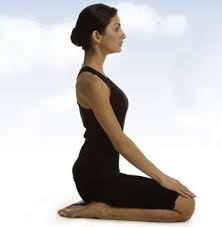
2.Downward Facing Dog Pose (Adho Mukha Svanasana) – This pose involves an inversion and it helps calm the body as well as stretch the muscles in the shoulders, calves, and hamstrings.
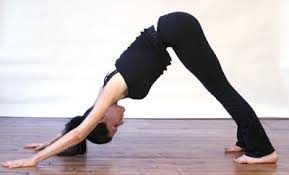
3.Child’s Pose (Balasana) – The Child’s Pose is a classic yoga pose to stretch the hips, thighs, and ankles. Any residual back pain or muscle fatigue felt at the end of the day also lessens with this pose.
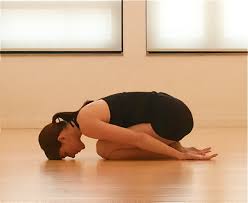
4.Goddess Pose (Supta Baddha Konasana) – This pose opens up the groin area and reduces stress stored in the leg muscles
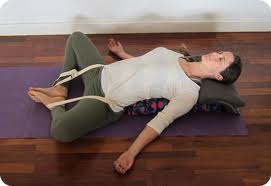
5.Legs up the Wall Pose (Viparita Karani) – The benefits of this pose include improved blood circulation and reduced pain in the lower back and hamstrings.
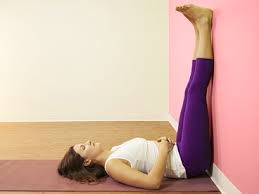
6.Crocodile Pose (Makarasana) – This relaxing asana calms the nerves and massages the heart. As your pulse rate slows down, sleep soon sets in.
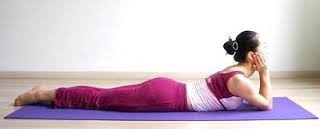
7.Seated Forward Bend (Paschimottanasana) – Best for easing tension in the spine and hamstrings.
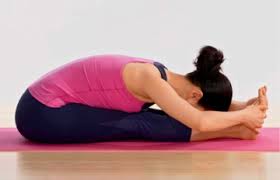
8.Corpse Pose (Savasana) – Most yoga classes end with this pose. It’s the perfect way to relax every muscle in your body and become aware of the rhythms of your breath before you fall off to sleep. Deep breathing also prevents your mind from wandering and stops the unceasing chatter in your head.
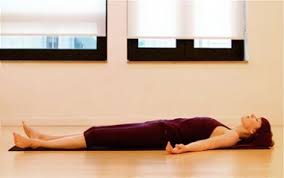
Apart from yoga exercises you could also listen to good and soothing music or chant some prayers in your mind. Follow meditation to prevent disturbed sleep patterns. Consult a yoga teacher for practicing each of the pose correctly.
Also read: Simple ways to include Ayurveda in Everyday life
In addition to yoga you can have a bath and then go to bed. The following sleep tips should help you maximize the quality of your sleep and regularize your bedtime habits.
- Keep a regular sleep schedule – it is important that you follow a regular pattern of sleep daily.
- Avoid sleeping for long during the day ,it can also interfere with your natural sleep cycle, therefore reduce your day time sleeping hours.
- Keep your bed exclusively for sleep. If you work at your bed, it will be more difficult to wind down for the night.
- Eat right and get plenty of regular exercise. Avoid having a big meal before you sleep as this can cause problems such as acidity or indigestion that can keep you up at night.
- Stay away from alcohol, caffeine and other stimulants before bed.
- Do not drink too much water before you go to sleep.
- Practice visualization and deep relaxation techniques to help you fall asleep.
Also read: Put an end to Snoring with Natural Home Remedies
You need to remember that what works for someone else may not work for you. Keep experimenting various patterns for a day or two until you hit upon the perfect combination that is most beneficial to you.
Please add a comment and, if you like the post, feel free to share it with your friends. You can also visit our Facebook page and Google plus page for more insight on other articles.
Follow the Process of Meditation in 5 Simple steps
December 8, 2014 by admin
Filed under General Advice, Tips for Ayurveda
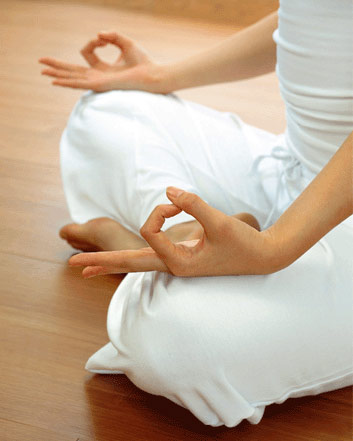 Meditation reduces stress better than any other form of exercise. By practicing meditation your body gets some time to rest physically and mentally, it also has a very direct effect on your entire nervous system by reducing your body’s production of stress related chemicals like cortisol, and increasing the production of mood enhancing chemicals like serotonin.
Meditation reduces stress better than any other form of exercise. By practicing meditation your body gets some time to rest physically and mentally, it also has a very direct effect on your entire nervous system by reducing your body’s production of stress related chemicals like cortisol, and increasing the production of mood enhancing chemicals like serotonin.
Meditation will improve your health by strengthening your immune system, reducing your blood pressure and lowering cholesterol levels. Therefore it is advised to practice meditation on a daily basis. The simple form of meditation is Still Meditation or Mindfulness Meditation, and can be done at any place whether you are at home or while you are traveling.
The ideal time for meditation is early in the morning when there is peace and freshness in the air. The family members are asleep and therefore you can allocate time without any interruptions.
-
Choose your meditation spot
Choose a private place free from external disturbances. You should feel safe, at peace and comfortable in it. If you have a bedroom to yourself, it is probably the most appropriate inside your bedroom. After you pick the spot, clean the space around it. Remove any pieces of clutter lying around.
You can opt for your bed or a mat spread on the floor. You can also use a table as a meditative altar with crystals, rocks, flowers and candles.
-
Sit in a comfortable position
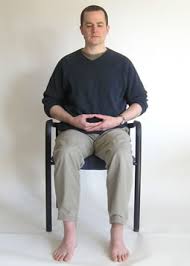 Different positions are recommended for doing meditation eg: lotus position. But you can quickly get into the habit of meditation by sitting in a cross-legged position on the bed or on the floor. This is easy and comfortable. Some people do feel the numbness in their feet when sitting cross legged. In that case you can sit directly on the chair. Whatever posture you choose, you should sit upright to facilitate the flow of energy.
Different positions are recommended for doing meditation eg: lotus position. But you can quickly get into the habit of meditation by sitting in a cross-legged position on the bed or on the floor. This is easy and comfortable. Some people do feel the numbness in their feet when sitting cross legged. In that case you can sit directly on the chair. Whatever posture you choose, you should sit upright to facilitate the flow of energy.
-
Clear your mind
Free your mind, clear of all thoughts. Loosen yourself up. Take a few deep, slow breaths.
-
Sit back and observe
Now it is time to close your eyes, simply sit back and observe the inner dialogue playing in your mind. Let them float by. Just observe, don’t engage.
Many people probably think that in meditation, they have to force themselves not to think and block out all their mental thoughts. It is really quite the opposite. You let your mind continue to think, but you don’t engage. You take the role of a passive observer and watch them from the back of your head.
Say for example, if you have a sudden thought that says ‘I need to pay the bills tomorrow’, observing it means knowing that particular thought is there. If you proceed to react from the thought, such as feeling annoyed that you have to pay the bills, or thinking about the budget and monetary arrangements, you are engaging with the thought. Don’t do that. Your desired state in meditation is to observe these thoughts, not engage with them.
One way of detecting when your focus breaks is to count slowly from 1, 2, all the way to 10. Repeat when you reach 10. Each time your focus is deviated, take note of the last number you were reading – this is an indicator of how long you held you focus. Try again, restarting from 1, and try to go beyond the last number this time.
The presence of these thoughts during meditation means they are being cleared. These thoughts have always been present in your mind, you are just not aware since there are so many thoughts screaming for attention inside your head! And now through meditation, they are clearing out, one by one. After repeated meditations, you will gradually reach a new level of mental Zen-like quietness. If you think your mind seems quiet now, try meditating a few days in a row – you’ll notice a new found mental peace.
Meditate for as long as you want, till you feel cleansed, purified, refreshed and good to go. For a start 20 minutes would be ideal. If you want to meditate longer, that’s even better.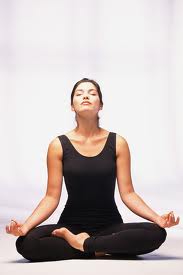
-
Ending Your Meditation
When you are done with your meditation, slowly ease into the physical state. Start off by being present of the physical reality around you. Next, be aware of your physical body. This can take 15~30 seconds, or however long you need to do this step. Then, very slowly, open your eyes. Get attuned to your surroundings. If you open your eyes immediately and try to resume your physical activities, it might be disjointing and jarring.
Instead of resuming your physical activities immediately, you might want to continue sitting in the meditative spot and reflect upon some of the thoughts, or images that came up during your meditation. You may also want to just spend a few minutes expressing gratitude towards the things you enjoy in your life.
Watch outs while doing Meditation
Do not fall asleep during the process of meditation. Staying awake is one of the largest difficulties for individuals who are new to meditation since there is no active stimulus to keep you engaged.
Preferably meditate after a good rest. Your meditations will be more focused at an alert state. Once you successfully let the thoughts be cleared, you will emerge from the meditation more energetic instead – since your clutter is removed and your mind is now fresh.
Do not engage with negative feelings and thoughts. Recognize these feelings and thoughts, do not engage with them and continue to maintain in your meditative stance. Once you get past the point with the most resistance, you will ease into the meditative state very naturally.
The benefits of meditation include:
Stress Reduction, Improved Health, Improved Sleep, Slowed Aging, Emotional Stability & Positive Thinking, Happiness!
People who meditate are less stressed, healthier, they sleep better, and they have a more positive outlook on life. To summarize, meditation makes you a happier person!
Meditation is not just for relaxation. Its primary purpose is to develop the capacity to develop skillfully and gracefully to life’s difficulties and joys.
Please add a comment and, if you like the post, feel free to share it with your friends. You can also visit our Facebook page and Google plus page for more insight on other articles.
Why must Few Medications be Taken Along with food?
October 30, 2014 by admin
Filed under General Advice, Tips for Ayurveda
 I was surprised to hear that the doctor has prescribed medication to be taken along with food. I repeated the query to verify if what I heard was correct. This thought kept bothering the whole day and upon searching the net and got few answers. Summarized the findings:
I was surprised to hear that the doctor has prescribed medication to be taken along with food. I repeated the query to verify if what I heard was correct. This thought kept bothering the whole day and upon searching the net and got few answers. Summarized the findings:
Why Some Medications Should Be Taken With Food
Some drugs, like ibuprofen or aspirin, can irritate the stomach lining if you take them when you’re empty. So, they really need your meals in there to act as a cushion.
You need to simply follow the instructions as mentioned on the label of the medication or as prescribed by the doctor.
If the label mentions,” Take with Food” you need to have the medication during the meal.
Other medications, like those for blood pressure, mix up with the food so they can move very slowly into your system, to get their full effect.
If your label of the medication says, “Take on an empty stomach,” that’s a drug that doesn’t want any competition from food. You should take the tablet one hour before eating, or wait two hours after a meal.
Also observed that few people prefer to swallow the pill without water. Water or some liquid is essential to wash it down, and help it dissolve in your stomach. A glassful of water is ideal but if you are in a big rush, few gulps of water will do.
Why do we need to eat before consuming ‘some’ medicines?
Some medicines can irritate the inside of the stomach, eating something first minimizes this. Some medicines such as aspirin, can be quite harsh on an empty stomach, particularly if it sits in one spot in the stomach while being absorbed. Food acts like a diluent to spread the aspirin around so that it is absorbed more slowly, and spreads it to different parts of the stomach. Food aids the absorption of the specific medication .
Some medicine, like penicillin, need to be taken on an empty stomach, so that they are not competing with the food to be absorbed, or being changed by interaction with the food.
This is not a rule that must be applied to all medication, it is important to follow the instructions given on the label or leaflet coming with your medication. Some medication must be taken on an empty stomach.
Why must some medicines be taken with or after food?
Some medicines need to be taken with or after food. The six main reasons for this are outlined below.
1 – To reduce side effects of nausea or vomiting
2 – To reduce side effects of stomach irritation, including indigestion, stomach inflammation or ulcers
3 – To treat problems such as heartburn, reflux or indigestion
4 – To ensure the medicine is not washed away
5 – To ensure the medicine is absorbed into the blood stream properly
6 – To help the body process the meal
Medicines for diabetes, if taken by mouth, should usually be taken around meal times to reduce blood sugar levels after eating, and to avoid hypoglycemia (very low blood sugar).
Ayurveda, the science of life also advocates having meals on time and follow the instructions of the vaidya. Walking is essential after meals for good digestion.
Remember, if you have questions about your medication…you can always ask your doctor or the pharmacist for advice!
Please add a comment and, if you like the post, feel free to share it with your friends. You can also visit our Facebook page and Google plus page for more insight on other articles.







